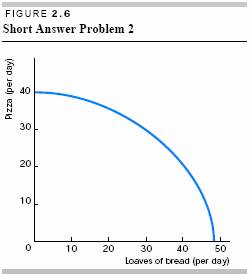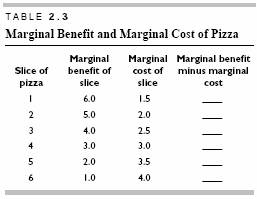
Q u e s t i o n s
Short Answer Problems
1. ˇ§In the future, as our technology advances even further, eventually we will whip scarcity. In the high-tech future, scarcity will be gone.ˇ¨ Do you agree or disagree with this claim? Explain your answer and what scarcity is. Why does the existence of scarcity require choices?
2. What are the factors of production? Focusing on the factors of production, describe the relationship between the big microeconomic question ˇ§How are goods and services produced?ˇ¨ and the question ˇ§For whom are goods and services produced?ˇ¨.
3. How do you think the standard of living changes in the different parts of the business cycle?
4. Why does your decision to buy a taco from Taco Bell reflect a tradeoff? Be sure to discuss the role played by opportunity cost in your answer.
5. ˇ§Education is a basic right. Just as kindergarten through 12th grade education is free, so, too, should a college education be free and guaranteed to every American.ˇ¨ This statement can be analyzed by using the economic concepts discussed in this chapter to answer the following questions.
a. What would be the opportunity cost of providing a free college education for everyone?
b. Is providing this education free from the perspective of society as a whole?
6. What does the negative slope of the PPF mean? Why is a PPF bowed out?
7. In Figure 2.6 indicate which points are production efficient and which are inefficient. Also show which points are attainable and which are not attainable.

8. Sydna is stranded on a desert island and can either fish or harvest dates. Six points on her production possibilities frontier are given in Table 2.2.
a. In Figure 2.7 plot these possibilities, label the points, and draw the PPF .
b. If Sydna moves from possibility c to possibility d , what is the opportunity cost per fish?
c. If Sydna moves from possibility d to possibility e , what is the opportunity cost per fish?
d. In general, what happens to the opportunity cost of a fish as more fish are caught?
e. In general, what happens to the opportunity cost of dates as more dates are harvested?
f. Based on the original PPF you plotted, is a combination of 40 dates and 1 fish attainable?
Is this combination an efficient one? Explain.


9. If the following events occurred (each is a separate event, unaccompanied by any other event), what would happen to the PPF in Problem 3?
a. A new fishing pond is discovered.
b. The output of dates is increased.
c. Sydna finds a ladder that enables her to gather slightly more dates.
d. A second person, with the same set of fishing and date-gathering skills as Sydna, is stranded on the island.
10. A nation produces only pizza and tacos. Table 2.3 shows the marginal benefit and marginal cost schedules for slices of pizza in terms of tacos per slice of pizza.
a. Complete Table 2.3.
b. For the first slice of pizza, after paying the marginal cost, how much marginal benefit ˇX if any ˇX is left?
c. For the second slice, after paying the marginal cost, how much marginal benefit ˇX if any ˇX is left? How does your answer to this question compare to your answer to part (b)?
d. Should the first slice of pizza be produced? Should the second one be produced? Explain you answers, especially your answer about the second slice.
e. In a diagram, draw the marginal benefit and marginal benefit curves. Indicate the quantity of pizza slices that uses resources efficiently.

11. Bearing in mind the point that resources are limited, explain why is it important for a nation to use its resources efficiently.